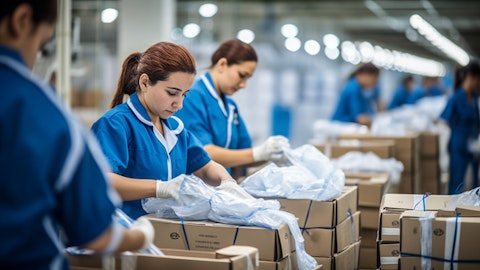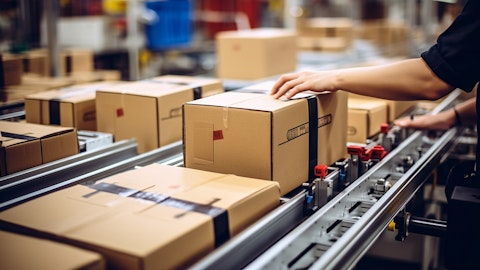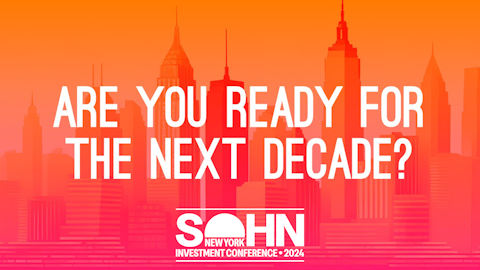Gabrial Hajde: I have one confirming question for us nonmaterial scientists on the call. So this PVdC discussion, to be clear, it’s a middle layer within a multilayer 9-, 11-layer film with no direct food contact. And more importantly — yes, prevents contamination, food waste. And you can today change the formulation at your customer request, although it may compromise some of these again extended shelf-life attributes.
Dustin Semach: Yes. So thanks for that question. The answer is yes. It’s a thin barrier level that manages oxygen transmission rate within our multilayer films. To be clarifying, we already offer both today, right? And it’s really based on customer preference, market need. And so at any point, if something changes from a regulatory environment, we’ll be well positioned to manage that transition. But it’s already offered today. It is that there’s no food contact associated with it. It is obviously fully FDA-compliant.
Operator: And our next question comes from the line of Adam Samuelson with Goldman Sachs.
Adam Samuelson: I guess, wanted to just get an update on price/cost. Certainly, there is still pricing pressure in Protective as well as well as Food. But just price — if I’m looking at the business for the quarter, price/cost seems like it was a much smaller drag on the business year-on-year than maybe had been previously contemplated. And maybe put another way, can you help us bridge some of the year-on-year margin expansion in the Protective business and just help us think about where — I mean, volumes are still — were still negative. Help us think about how you got that much kind of leverage and EBITDA expansion in the — on the Protective side.
Dustin Semach: Adam, great question. And I’ll start with just kind of giving you a bridge holistically around net price realization, so appreciate the question. And just to start there, we expect net price realization to be in the order of magnitude of around $80 million negative year-over-year, right? That’s about $140 million of price offset by a benefit in direct materials of about $100 million and then offset by some of that inflationary, albeit much smaller than prior years, around think of it as labor and nonmaterial cost as well, so it’s about negative $40 million. That gets you to that negative $80 million. That’s actually about $15 million worse than we had originally anticipated. And a lot of that’s coming from a little bit of, let’s say, increased price pressure that we see overall.
And that’s being offset by the productivity benefits more broadly in the business. Now just keep in mind, while we’re driving our CTO2Grow program, which is restructuring the holistic business, we’re always continuously driving productivity in underlying business. And a lot of what you’re seeing in Protective, if you go back to that cost takeout program and you go back to Q1, which, keep in mind, was a very low quarter in 2023 for Q1, specifically for Protective, that a lot of the actions that we’ve been taking in terms of cost control, productivity, footprint rationalization, SG&A optimization have all really been targeted in that Protective business. And that’s why you’re seeing some of the benefits you’re seeing today.
Operator: Our next question is going to come from the line of Christopher Parkinson with Wolfe Research.
Christopher Parkinson: Can you just take a step back and just looking at some of the businesses that you’re referencing, the movement in Food and improvements? Can you just take a step back and talk about a little bit more how you are thinking about your product portfolio, what you’re seeing by geography? Obviously, there’s been a lot of noise across protein markets the last few years. It seems like things are turning generally for the positive. But I’d love to hear your perspective on how confident you are to fully benefit from these improvements, or at least stabilization, let’s say, for the balance of ’24.
Dustin Semach: Yes, thank you, Chris. And so I’ll start with Food, then I’ll move to Protective. And so we feel really strong about Food holistically. Going back to where our strength is, we continue to be the market leader in our overall bags business. We’re continue to gain share. We’re really good about that, outside of kind of the market ebb and flows on kind of global proteins, particularly as it relates to fresh red meat, specifically beef. And in this note, we’ve talked about the fact that this year is obviously a down year in the cattle cycle and is going to take a couple of years to work through that. But we feel really good about our placement and from a portfolio perspective. And again, it’s that combination that drives it around material science, automation as well as technical service.
When you think about it, what we talked about in Q1 — or excuse me, during Q4 earnings call and what we’re still focused on, and Emile alluded to it a little bit earlier, is really rounding out our rollstock portfolio. We see that as an area of continued growth. We’re not the market leader in that space today. And that’s part of what creates — it’s a much larger market as well, much more fragmented. And so we feel our focus from a portfolio perspective is continuing to round out that offering set and make sure it’s competitive in the marketplace. And so we’re targeting specific applications that we’re going after. And an example would be today, the strength of our poultry business by extending that into other areas. And then when you move to — and then the third piece is just from a category perspective is the trays, right?
We see a huge opportunity, think about sustainability themes around EPS, kind of the bans coming in place for that, the compostable tray we launched. But there’s many other formats from a tray perspective that we’re working on that we’re excited about. And so we continue to see that as a potential opportunity for true net new growth going forward. And think of that as multiyear beyond just 2024 but into ’25 and ’26, right? And then as you shift gears and you go to Protective and you think about the portfolio there, it really is that completion and completing the overall fiber-based portfolio and continue to extend some of the automation capabilities that we have. And the focus there, Emile alluded to it earlier, around the paper mailers, which is a huge opportunity as you think about the e-commerce trends around a shift away from boxes into mailers more broadly.
If you think about, when you talk about 2D rightsizing that we already have today, 3D that we’re beginning to generate sales on that will come into play in the second half of the year, it’s those areas that gives optimism. The area that we’re still looking at and cautiously optimistic about is the rest of that broader portfolio. Think of it as utility, this is classically BUBBLE WRAP, foam, et cetera, where you still see kind of weakness in Q1. And a lot of the channel checks we’re doing in talking to our distributors kind of as you think about the rest of the back half of the year, they continue to be no different than we talked about in Q4, optimistic about the second half. But no one at this point in time has true line of sight, right? So that’s the area that we’re continuing to work and gain momentum.
And I’m going to turn it to Emile.
Emile Chammas: Yes. Just going to add one area that we haven’t talked a lot about the last months, but it’s on the fluids segment as well. We continue to be excited about the fluids segment and the growth there, be it through some of our innovations around FlexPrep for the foodservice area. But also, if you think about it holistically with all the sustainability and recycling pressures out there, there’s going to be more and more pressure for people who are in rigids business, be it plastic or nonplastic, to go towards flexibles. So we’re well positioned in terms of not only driving growth through our own innovations, but also how do we take advantage of those sustainability trends to penetrate further in terms of rigids to flexibles conversion.
Operator: And our next question is going to come from the line of Anthony Pettinari with Citi.
Anthony Pettinari: Dustin, on the last call, you talked through the net pricing outlook for ’24. And I’m just wondering if there’s any update on those items. I think you talked about $60 million negative net price and with some moving pieces from raw material prices and the bonus pool restoration. So I’m just wondering if there’s any material changes there. And then the $20 million EBITDA drag from net price in 1Q, was that in line with your estimates, better or worse? Any thoughts there?
Dustin Semach: Yes, great question. So I mentioned this a little bit earlier, and I’ll break down kind of where we’re at today. We’re about $15 million worse, $15 million to $20 million. Year-over-year, our net price realization has driven primarily the increase in pressure a little bit from a pricing standpoint. We’re roughly negative $140 million of price offset by $100 million of benefits of direct material cost. And then that’s being offset by inflationary pressure in nonmaterial, nonlabor costs as well as labor cost. And that kind of brings you back down to roughly a net $80 million number for the full year. Q1 was really driven by — so that’s net price realization. We feel good about that for the remainder of the year as we kind of manage throughout this.
And again, we’re obviously really focused on cost control right now. When you think about Q1, the benefit in a lot of ways was kind of the performance from a volume perspective, the leverage that drives the business. We’ve talked about it but not enough in the sense of that as volume comes back and is restored, particularly you’ve seen in Food in Q1, but you’re seeing it even somewhat in Protective as that business has stabilized, is that you’re seeing the ability of that business to drive leverage in it, operating leverage. And then that’s also benefiting from just continued focus on CTO2Grow, being cost-conscious, broader productivity benefits in the business. And you saw that materialize in Q1, right? And so from a bonus restoration perspective, it’s really just in line right now for the full year.
So we’re still driving towards — you still have that impact. That impact is already embedded in everything that we just talked about in our guidance as well.
Operator: And our next question comes from the line of Arun Viswanathan with RBC Capital Markets.
Arun Viswanathan: I guess, I just wanted to come back to a similar line of questioning around the bridge. So my understanding was you’re expecting about plus $90 million from CTO2Grow. And it sounds like you’re now expecting minus $80 million for net price/cost. So that’s a plus $10 million net. And then you have the minus $60 million for incentive comp. And so that’s a minus $70 million net. And so when you think about volume, it looks like if you think about flat volume, really it would be kind of negative volume that would get you to that kind of flattish EBITDA year-on-year outlook. So could you just update on how you guys think volume should progress from here? I know Food outperformed a little bit, but Protective is still down. It looks like it’s down about 22% on a 2-year stack. So does that kind of flatten out as you move forward? Or how do you think about volume and relate that to the bridge?
Dustin Semach: Sure. Yes, so I’ll come back to the bridge as a last point. But just talking about volume progression throughout the year, if you look at the total company level, right, and you think about how volume is going to continue to progress, if you think about right now, today, we drove about 0.5 point of growth in Q1. And then if you think about as you go to Q2, where we’re down about 1.5 points, and then you’re going to expect the rest of the second half of the year really in this — think of it as total around 2%, 2.5% per quarter. That drives you to about one point of volume growth in the full year. It’s really being driven all by Food. So if you break it down by overall businesses and you go back to Food for a second, Food volume, you’re looking at 3%.
And that’s the strength that we talked about earlier today at length. And if you think about Q2, it’s flattish for the reasons that we’ve already outlined. And then those wins coming through in the broader business, you’re looking at low single-digit growth that gets you to about 2% to 3% for the full year. And then if you go to Protective, Q2 is going to be a similar result. It’s improved year-over-year from Q4. So think of it as down 5%, now you’re down 4%, we’ll continue to be down 4% in Q2. Then as you get to the second half of the year, it begins to improve, right? And we talked about that to where we think it will inflect kind of during the Q4 time frame, right? So if you think about bridging for the full year holistically, that net price realization of about negative $80 million that we talked about, the plus $90 million, then you have a negative $40 million roughly related to the bonus restoration and a positive $20 million related to volume.
And these are all again rough numbers.
Operator: Our next question comes from the line of Phil Ng with Jefferies.
Phil Ng: Congrats on a strong quarter in a choppy environment. I guess, my question is on Protective. It looks like volumes have stabilized. But you did call out perhaps EMEA is a little weaker. You’re seeing some destocking and sustainability pressure. Is that a material risk in how to think about your demand profile this year? Appreciating comments around being refocused on the commercial team on Protective and kind of driving fiber on the Protective side, how does that margin profile look, an aspiration when we think about 2025? Give us some perspective as how big this could be. And when we look at the recovery next year, are some of these headwinds that you’ve called out limiting your ability to grow? Or we should see a typical cyclical recovery in that business like we’ve seen in past cycles?
Dustin Semach: Yes, so a great question. And I’ll start with the EMEA comment. And you’re right, we did rightly call that out, it was down significantly in Q1. And really, that’s an extension coming out of 2023, where I would say, if you go back to ’22, where the volume really came down that business, EMEA was — came a little bit later in that cycle in terms of actual volume decline. And it’s kind of — kind of think of it as last in and last out relative to this. So as we progress, we see Q1, we see that business to substantially improve as we go to Q2, Q3 and Q4. The sustainability pressures are still being overall — or we did make the comment around the acceleration. And acceleration is that shift to fiber, where you see it more quickly happening within the EMEA business than you do you see it relative to our Asia Pac or obviously our U.S. and North American business or Latin American business.
And right now, we don’t see that. Because keep in mind, our EMEA Protective business is, I want to say, roughly 20% of the total Protective business that we see, one, the work that we’re doing from an overall portfolio perspective will allow us to begin to participate in a more meaningful way in the growth in that transition, which will help offset some of the sustainability pressures that we just discussed. And then more broadly, we still believe that business is set up for a cyclical rebound. I go back to we’re anticipating an L-shaped recovery. We’re still expecting that throughout this year. A lot of that will be dependent on how we perform in the second half. And as we mentioned on the kind of prepared remarks, we’re obviously looking forward to come back in that discussion in August to give you more clarity.
Because again, we still are operating in a low visibility dynamic environment. But there’s nothing from our point of view as we think about the underlying market growth trends that come with a rebound that we should be able to participate in that, albeit in EMEA, as an example, maybe at a slightly lower rate until we get our portfolio exactly where we need it to be.
Operator: Our next question is a follow-up question from George Staphos with Bank of America Securities.




